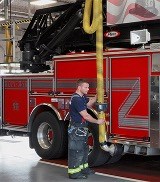September 13, 2021
Diesel engine exhaust emissions in fire stations can be deadly. These emissions expose firefighters and visitors to a multitude of health risks, including certain types of cancers.
The National Fire Protection Association 1500 specifies the minimum requirements for an occupational safety and health program for fire departments or organizations that provide rescue, fire suppression, emergency medical services, hazardous materials mitigation, special operations, and other emergency services. More specifically, the Standard also states, "The fire department shall prevent exposure to firefighters and contamination of living and sleeping areas to exhaust emissions."

Diesel engines like power a wide variety of vehicles at your station. But diesel exhaust is known to present several health hazards for firefighters, containing unburned hydrocarbons, carbon monoxide and nitrogen oxides.
A true diesel exhaust source capture system is the most efficient and effective way to capture these harmful gases. Direct source capturing systems that act like an extension of a vehicle’s exhaust system tailpipe and send exhaust to the outdoors offer a solution to diesel emissions concerns.
Federal Emergency Management Agency offers grants for departments looking to add a direct source capturing system to their department. The Assistance to Firefighters Grants (AFG) aim to "meet the firefighting and emergency response needs of fire departments and non-affiliated emergency medical service organizations."
 Back to Firewire
Next Post
Back to Firewire
Next Post

South Carolina State
Firefighters' Association
Physical Address:
111 Westpark Boulevard
Columbia, South Carolina 29210
Mailing Address:
Post Office Box 211725
Columbia, S.C. 29221
Email: [email protected] Phone: 1.800.277.2732 Fax: 1.803.454.1801
© Copyright South Carolina State Firefighters' Association 2021
Website by 37 Gears
The South Carolina Burned Children's Fund answered the Beaufort County Chief's Association challenge to donate to the South Carolina Fire Heritage Center. Be part of something historic - give today!